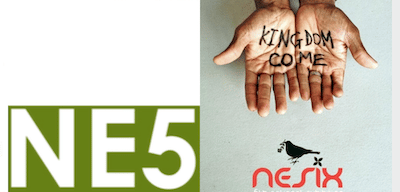
By Natalie Willis
Though artist and educator Kendra Frorup may be using the imagery of the banana flower in her work in “NE9: The Fruit and the Seed”, this is anything but a literal interpretation of this year’s theme. Frorup cleverly takes the image of the banana plant – whose fruit is rife with symbolism in the Caribbean and the world over – but takes on its less represented anatomy, the flower, and gives this to the audience for consideration. The plant that has become iconic in the region with slavery and plantations, as well as the more base and salacious hypersexualised iconography emerging from the difficult tropes the slavery era brought forth that we are still forced to contend with today.
Inflorescence/Influence (2018) sees Frorup taking the lived (and living) environment of The Bahamas and re-presenting it for our consideration. Works like this are an important exercise in thinking critically about the landscape we live in that sustains us, but that has been so affected by its past. Bronze casts of banana flowers, often referred to as banana hearts, hang from old rope in the center of the NAGB Ballroom in a cascading chandelier of pointed, weighted flowers. Rather than the phallic and masculine-associated icon of the banana, the feminine flower is the focus here, leading us to change tack and consider more the state of women surviving in this environment for a moment rather than that of the hypersexualised Black Caribbean man. Both are ripe territory for investigation, and have been the centre of much of the region’s scholarship respectively, but to use what is so often a ubiquitously masculinised image and association (the banana plant) and turn it around to its more feminine origins is a pointed and important shift. It speaks to not only womanhood and its history here, the survival through colonial eras, but also to fruitfulness, to abundance, to life brought forth – and also, to life lost.

“Inflorescence/Influence” (2018), Kendra Frorup, bronze and mixed media, dimensions variable. Collection of the artist. Work currently on view at the NAGB in “NE9: The Fruit and the Seed”.
Like pendulums or plumb bobs, the banana flowers swing, and the iconic song of protest by Billie Holiday comes to mind:
“Southern trees bear strange fruit
Blood on the leaves and blood at the root
Black bodies swinging in the southern breeze
Strange fruit hanging from the poplar trees”
– “Strange Fruit” (1939) by Billie Holiday
The flowers then become an homage to Black lives lost swinging from trees, particularly in the American South where Frorup has been living for years now during her time as an Associate Professor lecturing at the University of Tampa. The flowers are hanging bodies in many ways, poignant reminders on the one hand and a memorial of sorts on the other. Rings representing the circle of life emanate outward on the ground from one heart that has found its way to the earth. From the center in the grooves of the gravel laid beneath, we see that rocky soil that is the weight of the darker side of Black history that we find ourselves so often buried under but that we also find ourselves growing in spite of.
In looking to our growth in adversity, the way that the Caribbean feels so often to be the roses coming forth from the colonial-concrete bedrock, the rope suspending the hearts also begin to take on the look and role of umbilical cords in some ways. The ties to our past need not be ropes to lynch, but we can thank those who have passed on for the richness they add to our history and this soil and look to these connections as umbilical – ancestors giving life for us all to continue on though it may be a struggle. Just as the banana plant has its life cycle, bears fruit, and dies to bring forth a proliferation of new plants, so too does the influence of our past have its time on this earth before being buried and allowing new life to come out of the muck and mire.

“Inflorescence/Influence” (2018), Kendra Frorup, bronze and mixed media, dimensions variable. Collection of the artist. Work currently on view at the NAGB in “NE9: The Fruit and the Seed”.
Frorup’s intentions and inspirations for the work are far less morbid than the connotations they can stir up for us. Outside of the acknowledgement of the hard history, she looks to the banana’s inherent sense of regeneration, and even of community in the cycle of its life, taking her experience with artist residencies as a point of departure.
“Appreciating the skills of regional artists and interacting with them… I have rediscovered the social, cultural, historical, and intellectual resources of The Bahamas. Like the banana plant, from my root will come more trees through this collaboration and true exchange. During this time, I may have encouraged and influenced my peers through dialogue, techniques and skills, but I have also experienced a deepening of my own cultural awareness and sense of self.”
And so it comes full circle, this work that is not about a fruit as such but is entirely about the environment we live, thrive, struggle, and fight our way through.

